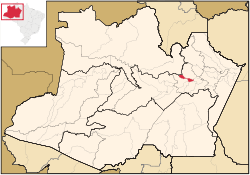Iranduba
| Iranduba | ||
|---|---|---|
| Municipality | ||
| Municipality of Iranduba | ||

Iranduba near Solimões River
|
||
|
||
| Nickname(s): "Cidade das Chaminés" ("City of Chimneys") | ||
 Location of Jutaí in the State of Amazonas |
||
| Coordinates: 03°17′06″S 60°11′09″W / 3.28500°S 60.18583°WCoordinates: 03°17′06″S 60°11′09″W / 3.28500°S 60.18583°W | ||
| Country |
|
|
| Region | North | |
| State |
|
|
| Emancipated | 1981 | |
| Government | ||
| • Mayor | Raymundo Nonato (PMDB) | |
| Area | ||
| • Total | 2,215.033 km2 (855.229 sq mi) | |
| Elevation | 92 m (302 ft) | |
| Population (2012) | ||
| • Total | 41,947 | |
| • Density | 18.94/km2 (49.1/sq mi) | |
| Time zone | AST (UTC-4) | |
| • Summer (DST) | DST no longer used (UTC-4) | |
| Area code(s) | +55 92 | |
| HDI (2000) | 0.694 – medium | |
| Website | Manaus, Amazonas | |
Iranduba is a municipality located in the Brazilian state of Amazonas.
The population of Iranduba in 2012 was 41,947 and its area is 2,215 km², making it the smallest municipality in Amazonas in terms of area. It is located south and west of Manaus on the right bank of the Rio Negro and the left bank of the Solimões River. It is connected to Manaus by the Manaus Iranduba Bridge, a cable-stayed bridge which opened in 2011.
The municipality contains about 21% of the Rio Negro Right Bank Environmental Protection Area, a 1,140,990 hectares (2,819,400 acres) sustainable use conservation unit that controls use of an area of Amazon rainforest along the Rio Negro above the junction with the Solimões River. It also contains about 80% of the Rio Negro Sustainable Development Reserve, a 103,086 hectares (254,730 acres) sustainable use conservation unit created in 2008 in an effort to stop deforestation in the area, which is threatened due to its proximity to Manaus.
...
Wikipedia

